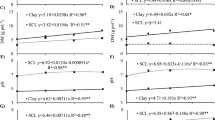Abstract
Granite (silicate) rock dust, a by-product of quarry operations, is being advocated and used as a fertilizer in the wheatbelt of south-western Australia (WA). The dust is insoluble and based on its nutrient element content (1.9% K and 0.3%P and negligible N) it is not expected to be a useful fertilizer. Previous laboratory studies and glasshouse experiments in WA suggest the dust is a slow release K fertilizer. This paper extends the previous studies to consider the dust as an NP or K fertilizer in the year of application in a field experiment on a soil deficient in N, P and K. In addition, the effectiveness of the dust as a K fertilizer was compared with the effectiveness of KCl (muriate of potash), the K fertilizer used in WA at present, in glasshouse experiments using K deficient soils. In the field experiment, compared with NP fertilizer or NPK fertilizer (urea, supplying N; superphosphate, providing P, S, Ca, Cu, Zn and Mo; KCl providing K), the dust had no effect on grain yield of wheat (Triticum aestivum); in fact dust applied at 20 t ha-1, for unknown reasons, reduced yields by about 65% compared to the nil (no fertilizer, no dust) treatment. Relative to the nil treatment, applying NPK fertilizer increased yields about threefold, from 0.54 to 1.79 t ha. The glasshouse experiments showed that, relative to KCl, the dust was from about 0.02 to 14% as effective in K deficient grey sandy soils for producing dried tops of 30-day old wheat plants or 42-day old clover (Trifolium subterraneum) plants. In soils with adequate K (yellow sands, sandy loams or clays, loamy clays, clay loams and clays), neither KCl nor the dust affected yields of 30 to 42-day old wheat or clover plants grown in the glasshouse. In the glasshouse experiments, no yield depressions were measured for the dust applied up to 17 g dust per kg soil (equivalent to 17 t dust ha-1 mixed into the top 10 cm of soil in the field). It is concluded that the dust has no value as a fertilizer.
Similar content being viewed by others
References
Baerug R (1991) Rock powder as a source of nutrients to different crops. 1. The magnesium effect of rock powder. Norsk Landbruksforkning 5: 183–188
Barrow NJ (1985) Comparing the effectiveness of fertilizers. Fert Res 8: 85–90
Barrow NJ & Campbell (1972) Methods of measuring the residual value of fertilizers. Aust J Exp Agric Anim Husb 12: 502–510
Blum WEH, Herbinger B, Mentler A, Ottner F, Pollak M, Unger E & Wenzel WW (1989a) Zur Verwendung von Gesteinsmehlen in der Landwirtschaft. I. Chemisch-mineralogische Zusammensetzung und Eignuns von Gesteinsmehlen als Bodenverbesserungsmittel. Z Pflanzenern Bodenk 152: 427–430
Blum WEH, Herbinger B, Mentler A, Ottner F, Pollak M, Unger E & Wenzel WW (1989b) Zur Verwendung von Gesteinsmehlen in der Landwirtschaft. II. Wirkung von Gesteinsmehlen als Dügemittel. Z Pflanzenern Bodenk 152: 421–425
Colwell JD (1963) The estimation of phosphorus fertilizer requirements of wheat in southern New South Wales by soil analysis. Aust J Exp Agric Anim Husb 3: 190–197
Coroneos C, Hinsinger P & Gilkes RJ (1996) Granite powder as a source of potassium for plants: a glasshouse bioassay comparing two pasture species. Fert Res 45: 143–152
Edwards NK (1993) Distribution of potassium in the soil profile of a sandplain soil under pasture species. In: Barrow NJ (ed) Plant Nutrition-from Genetic Engineering to Field Practice. Development in Plant and Soil Sciences, Vol 45. Kluwer Academic Publishers, Dordrecht, The Netherlands
Fragstein P von, Pertl W & Vogtmann H (1988) Verwitterungsverhalten silikatischer Gesteinsmehle unter Laborbedingungen. Z Pflanzeern Bodenk 151: 141–146
Gillman GP (1980) The effect of crushed basalt scoria on the cation exchange properties of a highly weathered soil. Soil Sci Soc Am J 44: 465–468
Hinsinger P, Bolland MDA & Gilkes RJ (1996) Silicate rock powder: effect on selected chemical properties of a range of soils from Western Australia and on plant growth as assessed in a glasshouse experiment. Fert Res 45: 69–79
Kahnt G, Pfleiderer H and Hijazi LA (1986) Wirkungen meliorativer Gaben von Gesteinsmehlen und Gesteinssanden auf das Wachstum verschiedener Landwirtschaftlicher Kulturpflanzen sowie auf physukalische Kennwerte eines Sandbodens und eines Tonbodens. J Agronomy Crop Sci 157: 169–180
Leonardos OH, Fyfe WS & Kronberg BI (1987) The use of ground rocks in laterite systems: an improvement to the use of conventional soluble fertilizers? In: Ogura Y (ed) Proceedings of the International Seminar on Laterite, 14-17th October 1985, Tokyo, Japan Chem Geol 60: 361–370
Loveday J (1974) Methods for Analysis of Irrigated Soils. Commonwealth Bureau of Soil, Tech Commun No 54
Mersi W von, Kuhnert-Finkernagel R & Schinner F (1992) The influence of rock powders on microbiol activity of three forest soils. Z Pflanzenern Bodenk 155: 29–33
Ross GJS (1980) 'MLP Maximum Likelihood Program', Rothamsted Exp Stat: Harpenden, UK
Sanz Scovinoo JI & Rowell DL (1987) The use of feldspars as potassium fertilizers in the savannah of Colombia. Fert Res 17: 71–83
Weerasuriya TJ, Pushpakumara S & Cooray PI (1993) Acidulated pegmatitic mica: a promising new multi-nutrient mineral fertilizer. Fert Res 34: 67–77
Walkley A & Black IA (1934) An examination of the Degtjareff method for determining soil organic matter and a proposed modification of the chromic and titration method. Soil Sci 37: 29–38
Author information
Authors and Affiliations
Rights and permissions
About this article
Cite this article
Bolland, M., Baker, M. Powdered granite is not an effective fertilizer for clover and wheat in sandy soils from Western Australia. Nutrient Cycling in Agroecosystems 56, 59–68 (2000). https://doi.org/10.1023/A:1009757525421
Issue Date:
DOI: https://doi.org/10.1023/A:1009757525421



